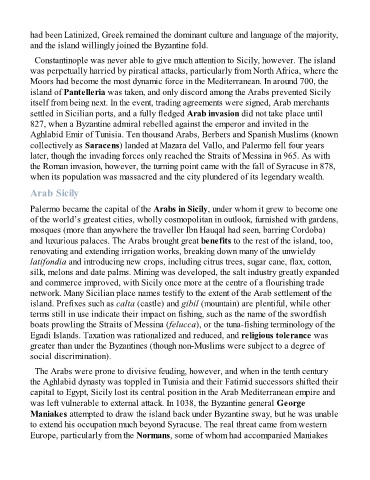Page 564 - The Rough Guide of Sicily
P. 564
had been Latinized, Greek remained the dominant culture and language of the majority,
and the island willingly joined the Byzantine fold.
Constantinople was never able to give much attention to Sicily, however. The island
was perpetually harried by piratical attacks, particularly from North Africa, where the
Moors had become the most dynamic force in the Mediterranean. In around 700, the
island of Pantelleria was taken, and only discord among the Arabs prevented Sicily
itself from being next. In the event, trading agreements were signed, Arab merchants
settled in Sicilian ports, and a fully fledged Arab invasion did not take place until
827, when a Byzantine admiral rebelled against the emperor and invited in the
Aghlabid Emir of Tunisia. Ten thousand Arabs, Berbers and Spanish Muslims (known
collectively as Saracens) landed at Mazara del Vallo, and Palermo fell four years
later, though the invading forces only reached the Straits of Messina in 965. As with
the Roman invasion, however, the turning point came with the fall of Syracuse in 878,
when its population was massacred and the city plundered of its legendary wealth.
Arab Sicily
Palermo became the capital of the Arabs in Sicily, under whom it grew to become one
of the world’s greatest cities, wholly cosmopolitan in outlook, furnished with gardens,
mosques (more than anywhere the traveller Ibn Hauqal had seen, barring Cordoba)
and luxurious palaces. The Arabs brought great benefits to the rest of the island, too,
renovating and extending irrigation works, breaking down many of the unwieldy
latifondia and introducing new crops, including citrus trees, sugar cane, flax, cotton,
silk, melons and date palms. Mining was developed, the salt industry greatly expanded
and commerce improved, with Sicily once more at the centre of a flourishing trade
network. Many Sicilian place names testify to the extent of the Arab settlement of the
island. Prefixes such as calta (castle) and gibil (mountain) are plentiful, while other
terms still in use indicate their impact on fishing, such as the name of the swordfish
boats prowling the Straits of Messina (felucca), or the tuna-fishing terminology of the
Egadi Islands. Taxation was rationalized and reduced, and religious tolerance was
greater than under the Byzantines (though non-Muslims were subject to a degree of
social discrimination).
The Arabs were prone to divisive feuding, however, and when in the tenth century
the Aghlabid dynasty was toppled in Tunisia and their Fatimid successors shifted their
capital to Egypt, Sicily lost its central position in the Arab Mediterranean empire and
was left vulnerable to external attack. In 1038, the Byzantine general George
Maniakes attempted to draw the island back under Byzantine sway, but he was unable
to extend his occupation much beyond Syracuse. The real threat came from western
Europe, particularly from the Normans, some of whom had accompanied Maniakes

